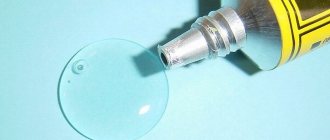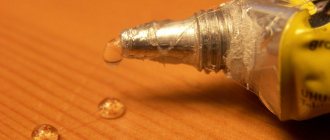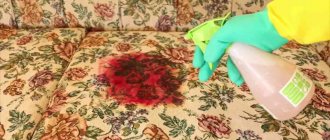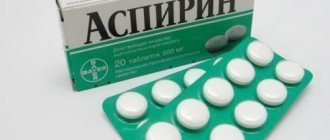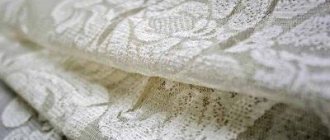Potassium permanganate stains from the surface of bathtubs are difficult to remove. Colored traces may remain after taking a pink medicinal bath, which is prepared from small crystals of potassium permanganate. Conventional soap products are ineffective against such contaminants. In such cases, store-bought and improvised devices will come to the rescue, the practice and experience of which have proven their effectiveness.
Removing marks from the skin
What to do if stains from potassium permanganate appear on the skin? What should I use to clean them? Don’t worry too much, because there are several ways to deal with this.
Hydrogen peroxide and acetic acid
You can remove pink marks using a combination of two components. Take hydrogen peroxide and vinegar and mix in the same ratio. Add the same amount of water. Wash your hands with the resulting solution. Residues should be removed under running warm water.
Medical alcohol
There is another good way to remove contaminants. Regular medical alcohol will help with this. Soak a cotton pad in the liquid and treat the stained areas. To get rid of the smell, wash your hands with laundry soap.
Lemon juice
If you don’t have the above ingredients on hand, lemon juice will come to the rescue. Cut the fruit into several slices. Squeeze out the juice and then mix with water. Apply the resulting solution to your hands and wash with soap.
"Whiteness" and oxygen bleach
On the Internet you can find another method of cleansing - soaking. Draw a bath, fill it with a solution of chlorine or oxygen bleach overnight, and wash it in the morning.
The method is unlikely to be suitable for everyday use. Its disadvantages:
- duration;
- high water consumption;
- inhalation of chlorine fumes is harmful to health;
- There is a risk that children and pets will get to the cleaning solution.
However, if the walls of the bathtub are covered with stubborn plaque that could not be removed otherwise, soaking with a concentrated solution can whiten the surface. When using this method, it is important to ensure safety - ventilation, thorough rinsing after draining. Be sure to limit access to the bathroom for children and pets.
Removing marks from fabrics
How to remove potassium permanganate from clothes? If a stain appears on the product, it is necessary to take action as soon as possible. Remember that a fresh stain is much easier to remove from fabric. There are several effective methods.
First way
Don’t know how to wash potassium permanganate? At home, you can quickly get rid of the trace using acetic or oxalic acid. Mix the ingredient with a little water. Then carefully apply the solution to the dirty surface.
Wait 7-10 minutes. To remove residues and get rid of unpleasant odors, the item should be washed using laundry soap or powder. This method is more suitable for light and white clothes.
Second way
How to remove potassium permanganate stain? Use an effective and proven product. Soak the soiled product in yogurt or kefir and leave for 5-7 hours. Then wash the item in cool water.
Third way
A fresh stain can be easily washed off using vinegar and soda. Place a teaspoon of baking soda on the dirty area and pour vinegar on top. A reaction will occur between the components. Once the foam has disappeared, wash the item as usual.
Purchased funds
You can get rid of colored plaque with the help of special preparations, which are easily purchased in the household department of the store. The most budget-friendly option would be traditional bleach, although it must be used carefully, since the aggressive effects of the chemical can damage the structure of the surface of the bathtub bowl. Stain removers will be effective. Application mechanism:
- Fill the bath to the brim with warm water.
- Pour in the required amount of the active ingredient and leave for 12 hours.
- When the time is up, drain the liquid and rinse the bowl thoroughly with strong pressure of running water.
If the procedure did not lead to the desired result, experienced users recommend increasing the concentration of the cleaner or using another product.
You can use chemicals that are specifically designed to remove difficult stains when cleaning the bathroom. Examples of funds:
You can purchase household chemicals for bathrooms.
- Domestos for baths;
- Cillit Beng for rust and plaque;
- Sarma for plumbing;
- Amway is a sulfate-free cleaner.
Before purchasing a specific product, you should study the instructions in detail, since each type of bathtub has its own specifics for care and cleaning. For example, an acrylic bathtub requires the use of special products for acrylic. The binding rule of care for all types of bowls is the ban on the use of abrasive powders and the use of metal brushes.
Removing marks from the bathtub
How to clean a bathtub from potassium permanganate or brilliant green? How to remove traces of antiseptic solutions depends on what the surface is made of.
Acrylic bath
How to remove potassium permanganate from an acrylic bathtub or sink? It is very difficult to clean a bathtub made of such material. Under any mechanical influence, acrylic bursts, resulting in the formation of microcracks. They are invisible to the naked eye, but gradually they become clogged with dirt and cannot be washed off.
To clean the bathtub, you need to take sandpaper and a special paste for painting the surface. First, wipe all dirty areas with sandpaper. As soon as the dirt is gone, treat with a white solution.
Enamel bath
It is much easier to wash off dirt from such a bath. How to remove traces with manganese? You can solve the problem with any cleaning agent, soda, bleach, vinegar, citric acid. It is enough to apply any selected product, wait a few minutes and wipe off with a sponge.
General rules
What do you need to deal with stains on the walls of the bathtub?
- Clean immediately after draining the solution - the shorter the exposure time, the easier it is to clean.
- Have a few homemade and store-bought products in stock so you don’t have to look for something to clean your bathtub with.
- Do not allow splashes to get on the seams of the tiles - they will be more difficult to clean than a smooth surface.
It is important to consider the material from which the bathtub is made. Acrylics are the most capricious and require gentle cleaning.
Removing stains from linoleum
How to clean dirt from linoleum? Experienced housewives claim that if potassium permanganate has not corroded the coating, then you can wash off the stain with bleach or citric acid.
To do this, you need to take a bucket, pour 3-5 liters of water into it, and pour in a bag of lemon powder. Mix thoroughly and treat the stained areas several times. Whiteness can generally be poured directly onto the dirt itself.
Some people say, “I clean marks with rubbing alcohol.” But before you start working, test the reaction in an inconspicuous area. If nothing happens, then continue the procedure.
If you cannot solve the problem on your own, then it is better to wash the linoleum in a sink. Specialists will select the right chemicals and carefully remove the stain.
Baby bath - special care
If your baby will be bathing in potassium permanganate, it is better to buy a small plastic or enamel bath. The consumption of water and permanganate is less, and washing a small bath after treatment procedures is faster and easier.
It is preferable to choose a light color - dirt is immediately visible on such products.
It is better to clean a baby’s bath with home remedies – vinegar or soda. Be sure to rinse well after washing.
To help housewives
In order not to spoil the bathtub, and also not to waste extra time and effort on cleaning, you must follow several rules:
- Permanganate must be dissolved in a separate container so that small crystals do not get into cracks or surface irregularities. Otherwise, they will cause staining that will be difficult to remove.
- In the treatment of fungal and genitourinary diseases, the pelvis can be used.
- It is necessary to drain the solution from a basin or baby bath gradually, without splashing, so that you do not have to wash two containers.
- It is important to follow safety precautions and not mix detergents: a chemical reaction with the release of vapors can cause burns, eye and respiratory tract irritation.
- Be sure to use gloves, a mask, and wash in a ventilated area.
- Abrasive and highly concentrated products are only permissible for cast iron, enameled bathtubs. Acrylic surfaces should not be rubbed with powder or a stiff brush, even if other means have not helped: this will hopelessly damage the material.
- Household chemicals should be stored out of the reach of children and hidden immediately after cleaning.
We recommend: How to clean darkened seams between tiles?
If, as a result of treatment procedures with potassium permanganate, the acrylic surface is damaged and it is impossible to wash it, you will have to buy a kit for repairing such products - it will restore the whiteness and also extend the service life of the bathtub.
How to clean a bathroom from traces of potassium permanganate
Quite often it happens that potassium permanganate is used in the bathroom, and due to the inconvenience of the bottle, there is a fairly high probability of carelessly spilling the substance into the bathroom.
As a result, it becomes covered with bright pink stains, which are not easy to get rid of; questions arise about how to clean the bathtub, and whether this is possible. The answer is yes, it is possible.
The method primarily depends on the bathroom. If it is acrylic, then use sandpaper to scrub off the potassium permanganate and paint over the stains with a special paste.
You won’t be able to remove stains from an enamel bath this way; you’ll have to stock up on the following components:
- soda,
- vinegar,
- special bleach,
- stain remover
To achieve results, you will have to try to use each of the means. This is due to the fact that, due to a number of circumstances, it is impossible to single out one universal remedy that will help remove traces of potassium permanganate from the bath.
The effect of each method depends on the degree of contamination of the bathroom with manganese and the size of the stain.
Wash stains carefully. Quite often there are situations when a person cleaned the bathroom and ended up dirtying the sink. Be careful when washing too. It is better to take the time to clean the bathtub once, rather than spend even more time scrubbing other plumbing fixtures.
Stains on hands
If your hands get dirty when using potassium permanganate, you can clean them with:
- lemon or vinegar - wipe your hands with a weak solution of vinegar or a slice of lemon, then rinse with water, repeating several times if necessary;
- hydrogen peroxide - apply the product to a cotton pad, rub the stained area and rinse well;
- vodka or alcohol - soak a cloth in one of these liquids, wipe your hands and wash them with soap;
- white spirit - it removes not only paint, but also potassium permanganate from your hands; to do this, treat the stain on the skin and then wash thoroughly with soap.
How to wash potassium permanganate from skin
Let's deal with the simplest question. There are several effective ways to wipe potassium permanganate from the skin.
To do this, you may need ingredients that are in every kitchen and every medicine cabinet, these are:
- lemon,
- mustard,
- vegetable oil,
- alcohol,
- peroxide,
- vinegar.
One of the most effective recipes is vinegar and peroxide mixed in equal proportions. They need to rub the skin until traces of the antiseptic are washed off. After which you should rinse your skin with clean water. This method must be used with caution, and those people who have cuts or other wounds on their skin should avoid this cleaning method altogether.
The next method requires only alcohol. Dampen cotton wool with it and wipe the stained area of skin several times. After this, it is recommended to moisturize your hands with cream.
The third method is the simplest. It is enough to wipe the contaminated part of the skin with a slice of lemon or lemon juice.
There is also a method according to which vegetable oil will wash away stains from the skin, having the necessary effect on potassium permanganate.
The effectiveness of all the remedies presented above has been confirmed by more than one person who inadvertently spilled potassium permanganate on their hands.
Why is potassium permanganate so difficult to wipe off?
Medical manganese is sold in the form of crystalline powder in plastic or glass vials. The substance appears dark, almost black.
For use, potassium permanganate is diluted in ordinary water. When it comes into contact with liquid, it turns it pink. The thickness of the color depends on the dosage of the powder. To get a glass of bright pink water, just dissolve the crystals in it on the tip of a knife. Potassium permanganate has this color due to its unique chemical composition.
Interacting with oxygen, potassium permanganate oxidizes and turns brown. As stains of the substance dry, they become persistent and are difficult to remove from surfaces. This is again due to the special properties of potassium permanganate, its ability to penetrate deep into tissue and crystallize upon contact with air.
The thicker the solution of potassium permanganate, the more difficult it is to wipe it off.
Why are potassium permanganate stains so persistent?
Potassium permanganate is a proven disinfectant. The brightness of its spots is determined by the chemical composition of the substance. It strongly eats into skin, fabric and various surfaces. After just a couple of minutes, the traces oxidize in air and turn brown. Simply washing them off with soapy water will not work. More effective methods are needed.
Potassium permanganate pigments are very durable
Operating procedure
The specific mechanism for removing potassium permanganate from a bathtub depends on the product chosen.
It is found in almost every home. If you didn’t know, baking soda is a good bleach that effectively removes many stains.
Vinegar
Another option for washing potassium permanganate, which can be found in almost any home. Since vinegar is an acid, it can break down most stains.
Lemon acid
It acts similarly to vinegar, since it is also an acid.
Another method of use is suitable for small baby baths:
Chlorine bleach
Thanks to the active action of chlorine, this bleach removes even heavy stains. However, it has a pungent odor and questionable health benefits. On the other hand, this method is suitable for cleaning a regular large bathtub.
Attention! We do not recommend using this method. Better pay attention to the next one.
Concentrated oxygen stain remover
No less effective than chlorine bleach, but much safer and more enjoyable to use.
If the effect is not what you expected, increase the amount of concentrate. But you shouldn’t bend it, as you can damage the bathtub coating.
Hydrogen peroxide
Cleaners
This is the simplest method:
Acrylic surface restoration kit
And this is the most difficult one, and it is intended for a certain type of bathtub. A repair kit for acrylic bathtubs is sold at any hardware store.
In this article, we looked at the simplest and most effective methods of how and with what to wash potassium permanganate from the surface of the bathtub. As you can see, most of the necessary components are found in every home. Please note that most stains are easier to remove when they are still fresh. Potassium permanganate is no exception. We also remind you to wear gloves!




